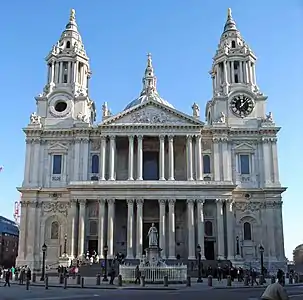English Baroque
English Baroque is a term sometimes used to refer to modes of English architecture that paralleled Baroque architecture in continental Europe between the Great Fire of London (1666) and the Georgian era, when the flamboyant and dramatic qualities of Baroque art were gradually abandoned in favor of the purer, more academically-correct neo-classical forms espoused by the proponents of Palladianism. It is primarily embodied in the works of Christopher Wren, Nicholas Hawksmoor, John Vanbrugh, and James Gibbs, although a handful of lesser architects such as Thomas Archer also produced buildings of significance. In domestic architecture and interior decor, Baroque qualities can sometimes be seen in the late phase of the Restoration style, the William and Mary style, the Queen Anne style, and the early Georgian style.


History
Sir Christopher Wren presided over the genesis of the English Baroque manner, which differed from the continental models by clarity of design and subtle taste for classicism. Following the Great Fire of London, Wren rebuilt fifty-three churches, where Baroque aesthetics are apparent primarily in dynamic structure and multiple changing views. His most ambitious work was St Paul's Cathedral (1675–1711), which bears comparison with the most effulgent domed churches of Italy and France. In this majestically proportioned edifice, the Palladian tradition of Inigo Jones is fused with contemporary continental sensibilities in masterly equilibrium. Less influential were straightforward attempts to engraft the Berniniesque vision onto British church architecture (e.g., by Thomas Archer in St. John's, Smith Square, 1728) and the contemporary mood soon shifted toward the stripped down orthodoxy of British Palladianism popularised by Colen Campbell's influential Vitruvius Britannicus. Baroque aesthetics, whose influence was so potent in mid-17th century France, made little impact in England during the Protectorate and the first Restoration years.
Colen Campbell, writing in 1715, declared the Italians had lost all taste for architecture in the pursuit of capricious novelties. Borromini was basest of all: "He had endeavoured to debauch Mankind with his odd and chimerical beauties, where the parts are without proportion, Solids without their true Bearing, Heaps of materials without strength, excessive ornamentation without grace, and the whole without symmetry."

Although Wren was also active in secular architecture, the first truly Baroque country house in England was built to a design by William Talman at Chatsworth, starting in 1687. The culmination of Baroque architectural forms comes with Sir John Vanbrugh and Nicholas Hawksmoor. Each was capable of a fully developed architectural statement, yet they were known to work in tandem, most notably at Castle Howard (1699) and Blenheim Palace (1705). Appuldurcombe House, Isle of Wight, now in ruins, but conserved by English Heritage, must also be mentioned.[1]
Castle Howard is a flamboyant assembly of restless masses dominated by a cylindrical domed tower. Blenheim is a more solid construction, where the massed stone of the arched gates and the huge solid portico becomes the main ornament. Vanbrugh's final work was Seaton Delaval Hall (1718), a comparatively modest mansion yet unique in the structural audacity of its style. It was at Seaton Delaval that Vanbrugh, a skillful playwright, achieved the peak of Restoration drama, once again highlighting a parallel between Baroque architecture and contemporary theatre. Despite his efforts, Baroque was never truly to the English taste and well before his death in 1724 the style had lost currency in Britain.
In the early 18th century, the style was associated with Toryism, the Continent and Popery by the dominant Whig aristocracy. At Wentworth Woodhouse, Thomas Watson-Wentworth and his son Thomas Watson-Wentworth, 1st Marquess of Rockingham replaced a Jacobean house with a substantial Baroque one in the 1720s, only to find fellow Whigs unimpressed. As a result, a large Palladian building was added, leaving the older one intact.
References
- "Appuldurcombe House - English Heritage". www.english-heritage.org.uk. Retrieved 20 April 2018.
- Downes, Kerry. English Baroque Architecture. London, A. Zwemmer, 1966.
External links
| Wikimedia Commons has media related to English Baroque architecture. |
